Tag: trees
Tree Care + Equity
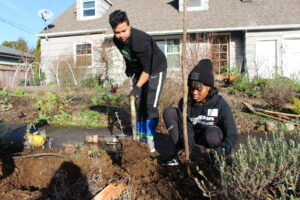 Most people by now are fairly well attuned to the benefits of trees environmentally, socially, mentally, and more. However, less people are aware of how tree canopy is distributed among a city and its neighborhoods.
Most people by now are fairly well attuned to the benefits of trees environmentally, socially, mentally, and more. However, less people are aware of how tree canopy is distributed among a city and its neighborhoods.
A trend across the country in large cities is that trees, and the benefits they bring, are distributed inequitably across neighborhoods based on race and income. Higher income neighborhoods with majority white residents have over 75% tree canopy coverage as compared to lower-income neighborhoods with around 15-30% canopy cover. These are large discrepancies that result in hotter environments, more air pollution, and factors contributing to respiratory conditions like asthma for children.
These trends are reality here in Portland: west Portland (excluding Forest Park) has about 75% canopy cover in most neighborhoods, while east Portland neighborhoods average about 15-30% canopy cover. Friends of Trees prioritizes planting street and yard trees in neighborhoods on the eastside of Portland to help decrease this disparity.
However, many people are wary about – if not outright opposed to – getting a tree of their own because of the costs of tree care, which can increase as a tree grows. This is just one of the reasons Friends of Trees provides tree care along with tree planting, including proper pruning of young trees at no cost to the property owner. And we’re exploring ways to increase the availability of low to no cost tree care for folks who need it, because we know the benefits of trees far outweigh the costs.
In the City of Portland, tree care and maintenance costs are the responsibility of the tree’s adjacent property owner. This is an inequitable financial burden for low-income households, renters, and populations vulnerable to gentrification. Many communities of color cite the financial burdens that a mature tree can bring as a reason to not want to plant trees next to their houses. It’s important to address these very valid concerns since trees have so many benefits, which is why Friends of Trees is continually working on creating programming that is responsive to community needs; in fact, we have funding proposals pending with Portland’s Clean Energy Fund that would help subsidize costs of mature tree care so we can grow our already considerable post-planting tree care services.
Understanding concerns about tree care
In 2018, Friends of Trees partnered with APANO and LARA Media to conduct three focus groups toward better understanding how community members viewed neighborhood trees and tree planting efforts. To increase accessibility these focus groups were conducted in multiple different languages including Vietnamese, Mandarin, and Spanish. Overall, many community members cited the benefits of trees within the city, including their health and environmental benefits:
“Trees are good for the lungs. They are the lungs of the city.”
“In the city, there’s big trees that make the air cooler. It also makes the city greener.”
–participants from the Vietnamese focus group
However, when asked if there are barriers for them to plant trees, many community members cited the long-term costs associated with mature tree care. One participant said: “One of the negatives is that sometimes Portland has a lot of storms and trees fall down when there’s strong wind. I experienced that once. The tree can fall into the house and collapse the house. Usually I try to hire a professional to cut the tree, but it [can cost] thousands of dollars. The tree bothers us.”
Trees and access to the natural environment are integral to healthy, livable neighborhoods. The benefits trees bring are strongest when they are mature, at least 10-15 years after they are planted. However, the fears community members have about the costs trees may bring are also valid, especially since the median household income on the eastside of Portland is lower and there are fears of being pushed out.
Friends of Trees is committed to equitably growing the urban forest through community-centered tree plantings. We offer tree care for the first three years of a tree’s life after it’s planted, including affordable (or free if cost is a prohibiting factor) summer watering service; free mulch; and structural pruning provided at no cost (see the next story for more about our pruning program). Structural pruning on a young tree is vital for its long term health, and can help prevent limbs falling onto a house or car later on in its life, since we can prune for the built environment and the tree will grow into that structure.
However, Friends of Trees also recognizes there are long term costs and concerns that need more support within our communities to make sure the urban forest is distributed equitably. We are continually working on creating programming that is responsive to community needs and when the opportunity arises we pursue grant funding to help subsidize costs of mature tree care. Because we know that, all in all, the positives of trees far outweigh the negatives; as our good friends at J Frank Schmidt like to say, “Trees are the answer.”
Photo: Street tree planting in east Portland, January 2020.
Leaflet: It’s Time To Put Down Some Roots
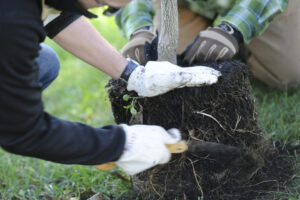
Last month, we told you why you should leave the leaves. We got such great feedback that we decided to create a regular tree care column, Leaflet, so that our eager experts can pass on their knowledge. We’ll share best practices for tree care and maintenance, explore common myths and misconceptions, and dig into the science behind it all.
“Now that the leaves are on the ground, we get busy,” says Neighborhood Trees Senior Specialist Drew Land about the November tree planting season. “Speaking of busy, roots are always busy.” We plant trees now so that while the trees are dormant above ground, they can focus on establishing their roots below ground. From timing to mulching to watering, our strategies help shape the tree’s root system.
“Street trees are not truly part of the urban forest until their roots start to intermingle,” Drew says. That’s why making sure a tree’s roots get established properly is a crucial part of planting and maintenance.
Because roots are almost entirely underground, we don’t really think about the shape of their structure. Rather than just a main tap root that goes straight down, 85% of a tree’s roots are within the top 24 inches of soil, or at least they should be. In the urban environment, roots are often up against the challenge of compacted and nutrient-depleted soil. In situations like these, roots will be too shallow, because they don’t have the space to seek out water and oxygen. Trees in the forest enjoy uncompacted soil with plenty of air and water spaces below ground. This also gives room for the fungal and microbial activity that brings soil to life.
“Roots are opportunists,” Drew says. “They follow the resources.” Given the right moisture and temperature, tree roots can grow year round. Insulation from mulch maintains those conditions, and we spread it in a way that encourages the roots to grow outward. Similarly, we shouldn’t just water at the base of a tree’s trunk, but should aim to water the tips of roots as they grow outward from the trunk. And we should water long enough that it sinks beyond the surface. Deep, infrequent watering mimics natural rain storms and gives roots what they need to spread both outward and downward. “Well-meaning people often shallow water on a daily basis, but that only feeds grass/weeds and not the tree roots a foot below. “
Tree roots come in two main types: structural roots and feeder roots. Structural roots are woody, and serve as the architecture to keep the tree upright. Feeder roots, which are much more like root hairs, are in charge of absorbing water and nutrients.
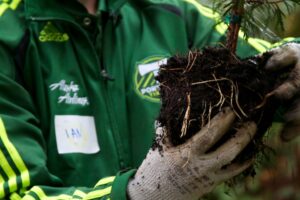
Maybe you have heard the myth that tree roots can grow into your sewer or water pipes and bust them open. Drew is here to officially bust that myth. He says that while roots are opportunistic, they are not invasive. “So the roots are not busting your sewer line,” he promises. “Your line is already busted and the roots found a tasty water source.”
Recreating ideal natural conditions is the best way to ensure that the roots of our urban trees stay healthy. “Roots are like muscles,” Drew says. “They grow in response to stress.” When you tie a newly planted tree too tightly to a support, it won’t have the freedom to move in the wind, building up those root “muscles” to support itself.
Getting the roots established is one of the most important reasons we plant new trees in the fall. “Planting trees now, while they’re dormant, will build their resilience,” Drew says. ”In ten months, when autumn winds hit their leaves for the first time, they’ll be ready.”
Further reading:
- “Roots Demystified” by Robert Kourik
- “Up by Roots” by Jim Urban
Tis the season … for Give!Guide

The 2020 Give!Guide is here!
Willamette Week’s Give!Guide runs through December 31st and is a great way to learn about organizations that are doing amazing work on behalf of people, places, critters and causes (including trees + community, of course ;).
G!G features Big Give Days when donors are entered to win fabulous incentives like shopping sprees, vacation packages, and more.
Why give? Now more than ever, we need trees! They fight climate change, clean our air and water, and make this place beautiful. And when planted the Friends of Trees way, with all kinds of volunteers, trees grow community (ands we need that more than ever, too!).
NOW is the time to get a tree

Tree lovers, we need your help! Not only have our community tree planting events changed quite a bit due to COVID, health & safety measures mean we have very limited ability to visit communities and help neighbors get a tree of their own.
Normally we reach thousands of potential tree recipients with door-to-door canvassers and through tabling at community events – things we just can’t do this season.
Less interpersonal interaction means we won’t reach enough households about getting trees planted. And reaching fewer households means that, without your help, our neighborhoods will have far fewer new trees – and we need trees more than ever!
Here’s how you can help:
- Get a tree planted at your home. If you’ve been thinking about getting a tree, now’s the time.
- Talk to your neighbors about getting a tree. How many tree-less front yards are on your street? How about tree-less planting strips? (the area between the sidewalk and street). Visit your neighbors (masked, of course 😉 and help spread the good word about trees through forwarding this email or sharing this link.
Getting a tree with Friends of Trees is easy, informative, and affordable!
- The cost to you for a tree is a very affordable $35. Considering that tree would sell in a nursery for much more, plus when it’s from Friends of Trees you get delivery, a hole dug, expert planters, and post-planting support, it’s a great deal!
- We have a sliding scale available if $35 is too much – name your price! And if you can afford more than $35 anything extra will go to our tree scholarship fund.
- Your tree can be FREE if need be, thanks to our tree scholarship fund (donate to the tree scholarship fund here!)
Check out how easy it is to get a tree, and our wide variety of trees, here.
Questions? Email or call the Tree Team at (503)595-0212. We can’t wait to introduce you to your new tree!
Please note that this information applies to the Portland Metro area; for information about getting a tree in our Eugene service area please contact our Eugene office.
This information was featured in the September 2020 edition of Treemail, our monthly e-news; read the whole issue here, and catch up on other Treemail issues here.
Trees for sale – at a great price!
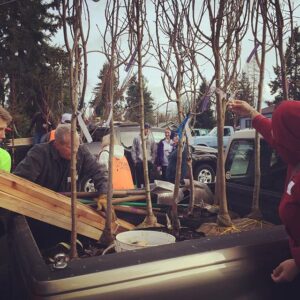
We have some trees for sale – at prices far below retail!
Most of the trees for sale are in containers and are a good size. Conifer trees are at least 5 feet tall; all other trees for sale are 8.5 feet tall with 1.5 inch caliper trunks.
Trees are $75 each, less than wholesale and far less than retail pricing.
Selection is limited and includes a few bigleaf maples, a few types of dogwoods, Persian ironwoods, elms, hornbeams, crabapples, and five different types of oaks. We cannot guarantee this selection so act fast if you’re interested.
Due to social distancing do not come to the office before contacting Gustavo about the purchase process.
Here are the steps to purchase a tree:
- Email Gustavo at [email protected] and put Tree Sale in your subject line.
- Gustavo will let you know what is available, will take your order, and give you payment instructions. Please note: payment must be with a credit card through our website, Gustavo will let you know how to make the purchase.
- Trees will be available for pick up beginning Monday, May 11. We cannot reserve a tree for you until you connect with Gustavo and payment is confirmed.
- Once your payment is confirmed Gustavo will let you know when you can pick up your tree at our office at 3117 NE MLK Blvd, Portland, and what that process will be. Delivery is not available.
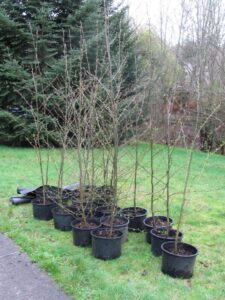 Please direct all questions to Gustavo. And please note that the above and left photos are not of the actual trees for sale, but they are similar in size and will actually have leaves.
Please direct all questions to Gustavo. And please note that the above and left photos are not of the actual trees for sale, but they are similar in size and will actually have leaves.
You can find tree care information here.
Thanks for planting trees and be sure to water your new tree 15 gallons a week through October!
